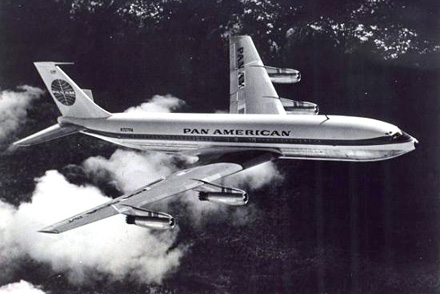The Golden Jet Age Started Today … 53 years ago
1958 was a big year for travel, starting on January 1st a BOAC Bristol Britannia broke the New York to London speed record, flying the route in 7 hours 57 minutes, followed by the first ever two-way moving sidewalk being introduced at Dallas’s Love Field and of course Boeing delivering the first ever 707 to Pan American World Airways (Pan Am) on the 15th of August.
While the de Havilland Comet may have been the first commercial jet airliner, the jet age, as people tend to think of it, began with Pan Am and the 707, and it started with the delivery of Pan Am’s Clipper America (N709PA), a Boeing 707-121.
The glamour and glory of airline travel has worn off over the years as commercial airplanes have managed to get larger while providing smaller seats, but our memories of the scent of jet fuel filling the air and the sound of spinning engines on the ramp all stem in some form from the four Pratt & Whitney JT3D slung under the 130 foot 10 inch long wings attached to the 145 foot 1 inch long white fuselage with blue stripe, punctuated by a 42 foot 5 inch tail emblazoned with the famous blue globe.
The last civil 707 may have rolled off the line in 1979 and Pan Am may have flown its last flight in 1991 … but together they made history and imprinted an indelible image in our minds of the golden age of the jet age.
Happy Flying!
EDITED: 1:25PM EST 15-Aug-2011 – Correcting aircraft registration from N710PA to N709PA as per Boeing’s Historian



I have shuttled between SFO and LHR all my life, with the first time as a baby in 1960. I have a clear recollection of the 707s Pan Am used to fly between the two airports and, if I can remember that the early ones couldn’t make it all the way, having to stop at Winnipeg for fuel on the westbound route. For some years after, the stop was dependent on the weather and then, finally at some stage in the 1970s they got 707s with enough range for a true non-stop.
I don’t remember the seat size in those days in Economy (and anyhow I was much smaller) but I do remember the open hat racks instead of overhead bins. I also remember them installing in-flight entertainment, which consisted of black and white portable tvs placed every few seats along in the hat rack. I also have a clear recollection of how the food deteriorated, culminating in the late 70s, near the end of Pan Am, being given the most disgusting food ever.
Flying the route today, by contrast, even in economy it’s not so bad. The food on United is edible, the seats are more ergonomic, the plane is quieter and the IFE, whilst (depending upon the equipment used) is either ancient or modern but with severely limited programming, is far better than anything before. If I get upgraded to business class, the accommodation is far far superior to anything that happened in the old days.
I would agree that the airport experience is now more crowded, but again I have clear recollections of the chaos of check in with Pan Am at SFO. There would be some 20 counters, each with its own ridiculously slow line, some20 people deep, moving very slowly and always even more slowly than the lines the other side. Yes, there was no TSA and yes, once airside the experience was better. However, overall I don’t agree that flying was massively better in those days. It’s like saying that driving from SF to LA in the 50s was better than today. Perhaps the roads were less crowded, but today’s roads are faster and the cars are so much more comfortable.
Oh the days… When i fly i like to dress nicely. Fedora ect.. Unfortunately all it ever gets me is a patdown.